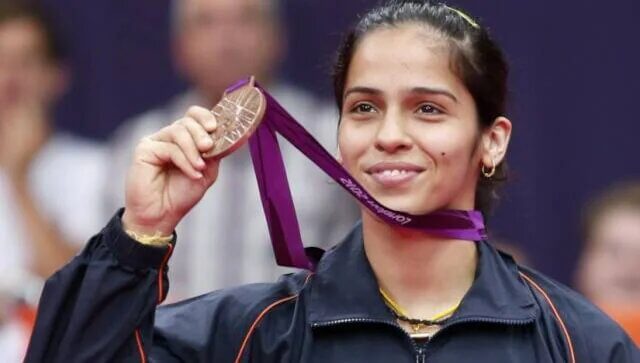Frontlist | Book excerpt from 'The Gopichand Factor': On Saina Nehwal winning bronze at 2012 London Olympics
Frontlist | Book excerpt from 'The Gopichand Factor': On Saina Nehwal winning bronze at 2012 London Olympicson Mar 10, 2021

'The Gopichand Factor' by Abhijeet Kulkarni has a chapter on Saina Nehwal where he chronicles her relationship with India coach and former player Pullela Gopichand.
Just before the start of the 2011 season, Saina Nehwal and Parupalli Kashyap wrote to the Sports Authority of India (SAI), stating that they wanted to train with Bhaskar Babu, who had been with the national squad for over four years by then. A few months ago, Pullela Gopichand had given Saina an earful after he felt that her personal life had cost her the Asian Games quarter-final against Yip Pui Yin. That dressing down had not really gone down well with the rising star of Indian badminton. The coach had also started spending more time with Sindhu, and that only led to more tension between the two. Though it was an internal arrangement, with Saina and Kashyap continuing to train at the Gopichand Academy, the cracks in the relationship were there for everyone to see when Gopichand did not even bother to console his most favourite pupil after she lost in the opening round of the India Open in Delhi against Japan’s Ai Goto in April 2011. Gopichand explained to the media persons wanting to understand what was going on that he was busy with some other matches, hence did not go to speak to Saina. The training continued away from the gaze of the media and Saina even went on to win the Malaysia Masters, beating Xin Wang in May, and all hell broke loose soon after the news broke of her opting to not train under the chief coach. Speaking to me, Saina had then mentioned the need for personalised attention as the primary reason for her to train with Bhaskar Babu. But neither Saina nor Gopichand could have afforded the scrutiny of the media at that moment, with the 2012 London Olympics just over a year away, and a compromise was worked out within days of this development. Read More - New NCERT framework to revamp early childhood learning AIIMS Psychology PhD not recognised by RCI, HC seeks reply IGNOU launches certificate programme in gender, agriculture and sustainable development Sindhu was still finding her feet on the international circuit and Gopichand knew that Saina was India’s best bet for a medal in London. He made his rules clear, shunted Bhaskar Babu out of the national camp to underline his authority, emphasised that he would not tolerate any insubordination and then went about preparing her for the Olympics. The Olympic qualification rules then allowed three players from one country to participate in the Games, provided all of them were in the top 4. This meant that Saina had to be seeded among the top 4 in London to avoid any of the three Chinese before the semi-final stage. She achieved that goal with her third Indonesian Open title, beating Li Xuerui of China in June 2012. The initial stage of the Olympics went according to plan and she got the better of Denmark’s Tine Baun to take her place as the only non-Chinese in the semi-final line-up. Saina was, however, outplayed in the semi-final by Yihan Wang and was really struggling to make an impact in the bronze medal playoff against Xin Wang until the Chinese left-hander ruptured her ACL at the end of the first game and conceded the match after just one point in the second game. Her detractors have since tried to dismiss her medal as a lucky break. But then one needs to understand that luck is an integral part of any sportsperson’s journey and things tend to even out in the long run. If Saina was lucky to win a medal in London, she can be considered extremely unlucky to lose out on one in Rio due to injury. I had visited Bengaluru in the run-up to the Rio Games and the way Saina was pushing herself, it would have been difficult for anyone to beat her. She had bagged her first World Championship medal in 2015 and had scaled the world ranking summit a few months earlier and was on a high when she started preparing for her third Olympics. But as luck would have it, she injured her knee a few weeks before the start of the Games. The medical professionals wrongly diagnosed it as fat pad inflammation and she decided to take a cortisone injection to relieve the pain ahead of her group matches. She managed to win her opening match against Lohaynny Vicente of Brazil but lost to Ukraine’s Maria Ulitina in what was her first loss against a player outside the top 50 in world ranking ever since she broke into the world top 10 in December 2008. She had to ultimately undergo a surgery and was out of action for over three months. Excerpted with permission from ‘The Gopichand Factor: The Rise and Rise of Indian Badminton’ by Abhijeet Kulkarni, Published by Westland Sports. Source: firstpost.com
2012 London Olympics
2016 Rio Olympic Games
Badminton
Book Excerpt
Frontlist
Frontlist Latest news
London Olympics 2012
Olympics News



.jpg)






.jpg)

.jpg)
.jpg)
.jpg)

.jpg)
.jpg)

.jpg)








Sorry! No comment found for this post.